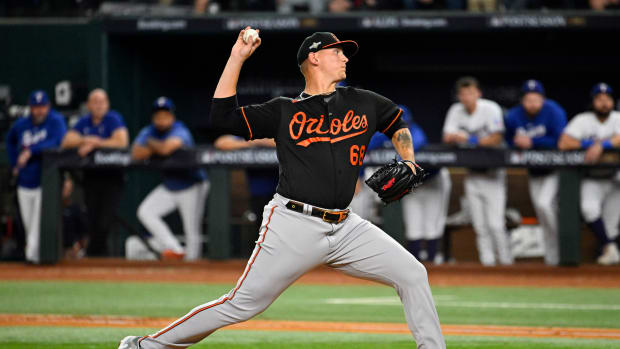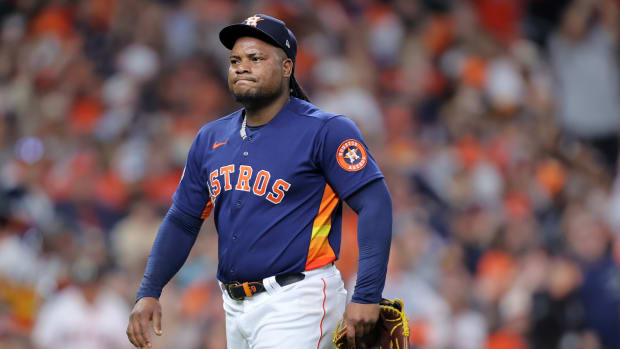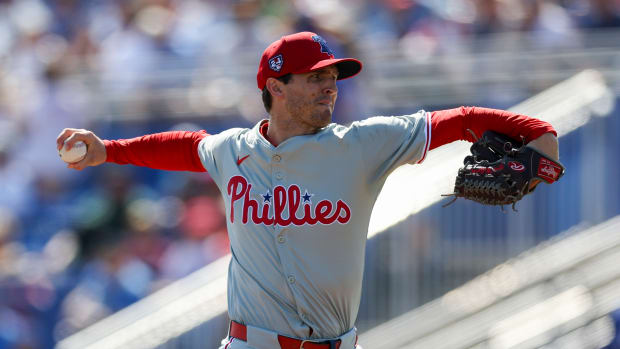World Series hope abounds, and more lessons from winter meetings
There was a saying among general managers only a decade or so ago that the worst place to be was in the middle of the road. You either built a team to win the World Series or you stripped it down with an eye on contending a few years later. Those days of a bifurcated baseball industry are dead.
The winter meetings re-proved a lesson we learned from the last World Series, the first one in history in which neither team won 90 games: You don't have to dream big to win a title.
Look at some of the teams spending money this winter with an eye on contending as soon as next year: the Blue Jays, Cubs, Mariners, Marlins, Padres, White Sox, etc. Can they win 90 games? Not likely in most cases. Can they win a pennant? Why in the name of a 29-year drought in Kansas City can they not?
Winter meetings roundup: Tigers get Cespedes, Marlins snag Latos
When Theo Epstein was trying to run down the Yankees with his Red Sox teams a decade ago, he would talk about the unrelenting pressure of having to build a 95-win team every year. Now, the dirty little secret in the competitive balance, 10-team-playoff world of departing commissioner Bud Selig is that no such pressure exists today. You can get away with building a team that wins 85-89 games, with the possibility that midseason acquisitions or unexpected breakout seasons from individual players can push you higher — if that's even necessary.
Look around. There are no more great teams. Nobody wins 100 games any more, a complete turnaround from the boom-or-bust era. In the nine seasons from 1997-2005, 17 teams won 100 games or more. In the nine seasons since then, only three teams have done so – including none in the past three years, the first time that's happened in the 53 years with the 162-game schedule.
Miley, Porcello, Masterson head to Boston as Red Sox rebuild rotation
Four teams made the playoffs last year without winning 90 games, a record for any non-strike season: the Athletics, Giants, Pirates and Royals. Those teams went 22-11 in the playoffs. The four teams that won 94 or more games — the Angels, Dodgers, Nationals and Orioles — went 5-13. October, with its four rounds of playoffs, has become another equalizer in addition to enhanced revenue-sharing, international and draft spending limits and the rest of Selig's master plan to give “hope and faith” to as many teams as possible.
There are no more five-year plans. Teams turn around on a dime, none more so than the worst-to-first-to-worst-to-here-we-go-again Red Sox. Look also at the Marlins, or at least try to without getting whiplash: from double-secret probation for pocketing revenue-sharing money, to wild spending in a new ballpark, to a fire sale and another warning from the union about not spending enough, to lavishing Giancarlo Stanton with the biggest contract in sports and a one-year rental of Mat Latos — all within four years.
The Padres trade for Matt Kemp. The Cubs win the bidding for Jon Lester. The Mets get Michael Cuddyer. The Mariners add Nelson Cruz to a roster with three $100 million players. Do these teams really think they can win? The answer is yes. The middle of the road is not so bad any more. Sometimes, like the 2014 Giants, with the eighth-best record in baseball the year after owning the 18th-best record in baseball, the middle of the road brings you to a title.
New front office puts its stamp on Dodgers with flurry of acquisitions
Where do World Series teams come from? Anywhere. Of the past 20 teams to reach the Fall Classic, half of them posted between 83-89 wins the year before their pennant, while the other half was split between really good teams (90-plus wins) and really bad teams (66-76 wins).
What separates teams — the good from the bad, the top of the heap from the middle of the pack — has become extraordinarily thin, which is not only why we don't see 100-win teams, but also why we see more close games. Since baseball became a 30-team industry in 1998, here are the four seasons with the most one-run games: 2013, 2011, 2014, 2010.
No wonder these meetings included a rarely seen flurry of trade and signing activity — almost none of it due to salary dumps because a team couldn't afford to keep a player. The activity was mostly driven by pure baseball evaluations in which teams asked themselves: How can we get better even incrementally? And part of what drives the churn is that reaching the postseason — even the World Series — has never been within the realistic view of more teams than it is today.
What else can we take away from the meetings? Here are five more lessons from all that activity:
1. It's never too late to have a breakout year.
Brandon McCarthy is coming off a season in which he turned 31 years old and pitched 200 innings for the first time in his life — and only the second season in which he pitched enough to qualify for the ERA title. His career record is 52-65 with a 4.09 ERA. Only five active pitchers with at least 150 career starts have a worse career winning percentage, and none of them are still starters. The way he throws a baseball puts severe stress on his shoulder, causing frequent stays on the DL. And yet the Dodgers guaranteed him four years, primarily on the strength of his 14 second-half starts with the Yankees, when he returned to throwing a cutter. It's a credit to McCarthy's determination over the years to keep trying ways to get better — and to staying healthy.
2. The Royals still are hard to figure out.
Three Strikes: Aggressive White Sox are offseason's biggest surprise
Kansas City paid Billy Butler, 28, a $1 million buyout rather than pick up his 2015 option for $12.5 million. Then they replaced him by giving $17 million over two years to 31-year-old Kendrys Morales. For those of you scoring at home, they gave more money to the DH who is three years older, who is coming off a worse season and who over the past two seasons has posted the lower OPS (.719 to Butler's .746).
3. Will the last one to leave the NL turn off the lights?
Ten free agents who signed multi-year contracts changed leagues. Seven of them jumped the NL for the AL. The only additions to the NL have been pitchers Jon Lester and Jason Hammel to the Cubs and outfielder Nick Markakis to the Braves.
4. The Dodgers could be a better team while scoring fewer runs.
Matt Kemp trade a sign that even Dodgers are playing by new rules
President of baseball operations Andrew Friedman, general manager Farhan Zaidi, senior VP Josh Byrnes and the rest of the deepest front office in baseball wasted no time turning over Los Angeles' roster. They solved the club's problems of having too many outfielders (saying goodbye to Kemp, who can't play centerfield any more and doesn't like leftfield), too much grumbling in the clubhouse (saying goodbye to Hanley Ramirez, the least popular player in the room last season), poor defense up the middle (no more Ramirez at shortstop, and Yasiel Puig, miscast in center, can go back to rightfield) and not enough reliability in the back end of the rotation (the Dodgers were 36-41 when their fourth and fifth starters took the ball).
Kemp did slug .606 in the second half of the season and Ramirez did put up an .817 OPS. Their thump will be missed. There is no true cleanup hitter if Adrian Gonzalez hits third and the lineup lacks depth if rookie Joc Pederson isn't quite ready. But the collection of talent should play better together, especially the double-play combination of Jimmy Rollins and Howie Kendrick, who bring an upbeat, professional attitude to a team that needs some glue.
5. Even the Twins are spending head-shaking money.
You would think lowly Minnesota would be wiser after last offseason, when it gave $49 million over four years to Ricky Nolasco, a 30-year-old righthander with a career 4.37 ERA and an ERA+ of 94. Nolasco went 6-12 with a 5.38 ERA in his first year for the Twins.
So along comes Ervin Santana, a 31-year-old righthander with a career 4.17 ERA and an ERA+ of 99. Last winter his agents tried to pitch him as a Zack Greinke-like $100 million pitcher, only for Santana to take a one-year deal from the Braves. This year the pitch was, "Well, he's better than Nolasco, Ubaldo Jimenez, Edwin Jackson and Matt Garza." So the Twins gave Santana, a decent pitcher, $55 million over four years. Why? Because they can.


































